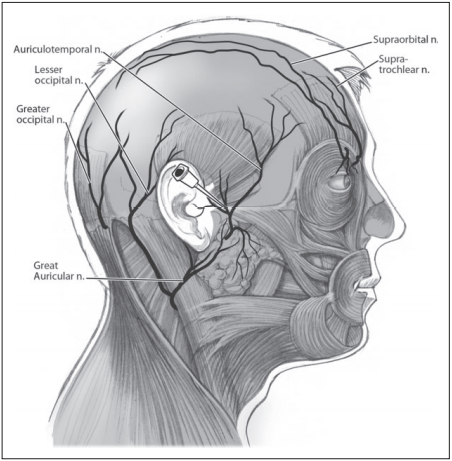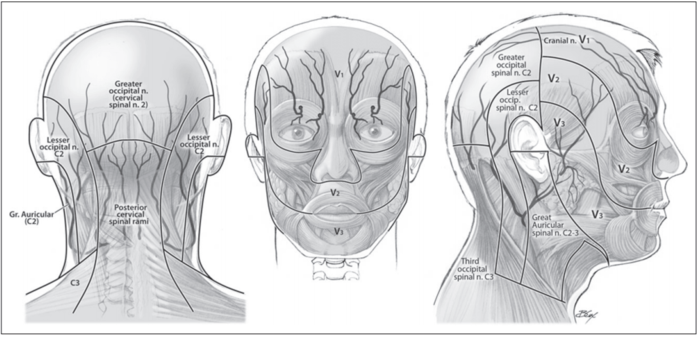Auriculotemporal Nerve Injection: Difference between revisions
m (Text replacement - "Head & Jaw" to "Head and Jaw") |
m (→See Also) |
||
| Line 29: | Line 29: | ||
==See Also== | ==See Also== | ||
* [[Greater Occipital Nerve Injection]] | |||
* [[Lesser Occipital Nerve Injection]] | |||
* [[Paraspinous Cervical Block]] | |||
* [[Third Occipital Nerve Injection]] | |||
* [[Supraorbital Nerve Injection]] | |||
* [[Supratrochlear Nerve Injection]] | |||
* [[TMJ Injection]] | |||
==References== | ==References== | ||
Latest revision as of 17:40, 7 March 2022

| |
| Auriculotemporal Nerve Injection | |
|---|---|
| Indication | Headache disorders and laceration repair |
| Syringe | 5mL |
| Needle | 27-30g |
The auriculotemporal nerve is a branch of the mandibular nerve (V3) that runs with the superficial temporal artery and vein, and provides sensory innervation to various regions on the side of the head.
Anatomy
The auriculotemporal nerve arises as a posterior division of the mandibular branch of the trigeminal nerve. It has somatosensory and parasympathetic roots. The somatosensory fibres supplies the auricle, external acoustic meatus, outer side of the tympanic membrane, the skin in the temporal region (superficial temporal branches), and a few fibres to the temporomandibular joint. Its proximal trunk is located superficially just anterior to the tragus. The parasympathetic root innervate the parotic gland.
The external ear innervated by four sensory nerves: greater auricular nerve, lesser occipital nerve, auricular branch of vagus nerve, and the auriculotemporal nerve.
- Cranio-cervical Dermatomes.[1]
Technique
Landmark Guided
- Position: patient seated and physician standing beside them, or with the patient supine and their head in a neutral position.
- Injection point is just anterior to the tragus
- Use a 5 mL syringe with a 30-gauge needle
- Insert the needle 1–2 mL into the subcutaneous tissue to a depth of about 4–6 mm.
- Aspirate to exclude arterial puncture and inject
See Also
- Greater Occipital Nerve Injection
- Lesser Occipital Nerve Injection
- Paraspinous Cervical Block
- Third Occipital Nerve Injection
- Supraorbital Nerve Injection
- Supratrochlear Nerve Injection
- TMJ Injection
References
Literature Review
- Reviews from the last 7 years: review articles, free review articles, systematic reviews, meta-analyses, NCBI Bookshelf
- Articles from all years: PubMed search, Google Scholar search.
- TRIP Database: clinical publications about evidence-based medicine.
- Other Wikis: Radiopaedia, Wikipedia Search, Wikipedia I Feel Lucky, Orthobullets,



